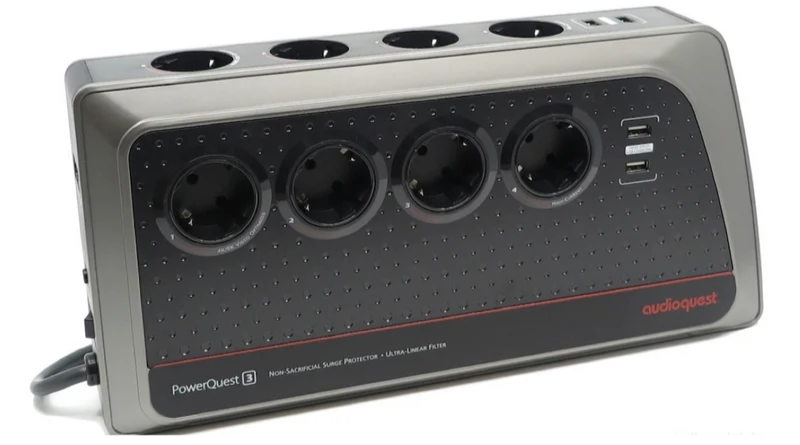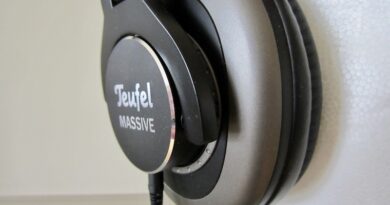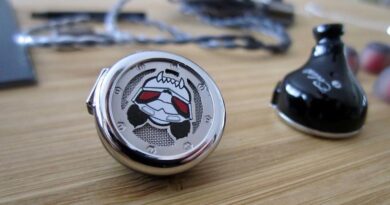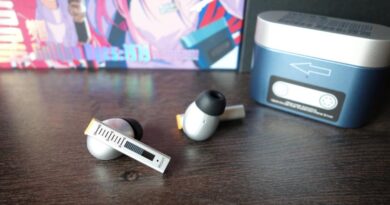AudioQuest PowerQuest PQ3 Review – Works Wonders If You Need It
In this Article
At-a-glance Card
| PROs | CONs |
| Effective power filtering yields audible sound improvement | Not all systems benefit from power filtering |
| Differentiate optimisations for power amps, HQ video, and audio sources | Investment opportunity assessment requires competence above consumer level |
| Protection from catastrophy-level surge spikes | |
| Protection from pernicious low level spikes and other anomalies | |
| Non-sacrificial architecture (re: power sockets only) | |
| Surge protection for data lines and USB powering/charging too | |
| Easy to use |
I am not writing these articles to help manufacturers promote their products, even less I’m expecting or even accepting compensation when I do. I’m writing exclusively to share my fun – and sometimes my disappointment – about gear that I happen to buy, borrow or somehow receive for audition.
Another crucial fact to note is that I have very sided and circumscribed musical tastes: I almost exclusively listen to jazz, and even more particularly to the strains of post bop, modal, hard bop and avantgarde which developed from the late ’50ies to the late ’70ies. In audio-related terms this implies that I mostly listen to musical situations featuring small or even very small groups playing acoustic instruments, on not big stages.
One of the first direct consequences of the above is that you should not expect me to provide broad information about how a certain product fares with many different musical genres. Oppositely, you should always keep in mind that – different gear treating digital and analog sound in different ways – my evaluations may not, in full or in part, be applicable to your preferred musical genre.
Another consequence is that I build my digital library by painstakingly cherry-pick editions offering the least possible compression and pumped loudness, and the most extended dynamic range. This alone, by the way, makes common music streaming services pretty much useless for me, as they offer almost exclusively the polar opposite. And, again by the way, quite a few of the editions in my library are monoaural.
Additionally: my library includes a significant number of unedited, very high sample rate re-digitisations of vinyl or open-reel tape editions, either dating back to the original day or more recently reissued under specialised labels e.g. Blue Note Tone Poet, Music Matters, Esoteric Jp, Analogue Productions, Impulse! Originals, and such. Oppositely, I could ever find an extremely small number of audible (for my preferences) SACD editions.
My source gear is correspondingly selected to grant very extended bandwidth, high reconstruction proweness, uncolored amping.
And finally, my preferred drivers (ear or headphones) are first and foremost supposed to feature solid note-body timbre, and an as magically centered compromise between fine detail, articulated texturing and microdynamics as their designers can possibly achieve.
In terms of presentation, for IEMs I prefer one in the shape of a DF curve, with some very moderate extra pushup in the midbass. Extra sub-bass enhancement is totally optional, and solely welcome if seriously well controlled. Last octave treble is also welcome from whomever is really able to turn that into further spatial drawing upgrade, all others please abstain.
Features and description
What is the PowerQuest PQ3?
Very simply put, PowerQuest PQ3 is an electrical multi-plug with some built-in circuitry offering two types of fundamental added values to the devices connected to it : protection from electrical damages and reduction of electrical noise.
Starting from the basics, PowerQuest PQ3 carries eight 220V Schuko sockets. On one end you plug its wired power chord into a wall outlet, on the other end you can plug up to eight 220V home appliances onto it.
There is a main power switch to turn all 8 outlets on/off at the same time, but no individual switches to shut single outlets off.
In addition to the 8 x 220V outlets, PowerQuest PQ-3 also comes with 4 high-power USB-A ports. So you can (also) use it as a USB charger, or as a (5V) USB power supply. Max amperage available for all of the 4 USB ports taken together is 4.8 A
Now let’s cover its main values.
A surge protection system
PowerQuest PQ3 contains circuitry designed to protect all devices connected to it from current or voltage spikes.
A lot of different ports are available for connecting various categories of devices, and have them all protected from catastrophic surge damages:
- 8 x 220V appliance sockets
- 4 x USB-A charging ports
- 2 x RJ-45 twisted pair ethernet ports
- 2 x RJ-11 twisted pair phone ports
- 2 x Coaxial ports
220V sockets are of course there to offer protection to electrical appliances or systems. USB-A ports will charge and surge-protect phones, tablets, and other appliances requiring 5V power supply.
The three RJ-45, RJ-11 and COAX port pairs will similarly protect the data or analog communication lines which are connected to them.
Let’s clarify with an example: instead of connecting your desk ethernet switch’s uplink directly to the RJ-45 female socket on the wall, connect that to PQ3, and the run another cable from PQ3 to the wall. This way PQ3 will filter-protect that data line. Similar scenario for the RJ-11 and COAX options.
Is such protection important? Well, yes.
High voltage and/or current spikes may come anytime, from anywhere: lightning, grid malfunctions from the outside, or even malfunction from the inside, such as another home appliance connected in another room going bust, and much more.
Depending on how your particular house / office plant is wired, such protection may, may in part, or may not be already there of course. For the majority of Italian apartment flats, for example, it’s there only “in small part”, so an extra level of protection plugged between the grid and my most precious appliances is far from pointless.
PowerQuest PQ3 offers protection from very significant spikes by the way: up to 6000V and 3000A. Huge numbers !
And while we are at it: “surge protection systems” can be grouped into 2 categories: sacrificial and non-sacrificial systems.
A sacrificial system is a device that may go as far as “giving its life for the cause”, that is, when a big slam hits the device absorbs it, safeguarding downstream connected appliances (totally, or in worst cases minimising damages), but may get internally damaged or even destroyed in the process.
A non-sacrificial system – you guessed it – is designed such as to always survive unharmed to the negative events it’s supposed to filter off.
PowerQuest PQ3 behaves as a non-sacrificial surge protector vs its 8 x 220V user sockets. It behaves the sacrificial way, instead, vs all of its other ports (USB, RJ-45, RJ-11 and COAX).
In addition to that, PowerQuest PQ3 will instantly shut down (power off) its 8x220V sockets, and of course all connected appliances with them, when it senses >270V (instead of the regular 230 max) over its mains supply. Its reaction time is 0,25s (one fourth of a second), and it will reinstate power to the connected devices as soon as it senses the main input voltage is back to normal.
I think it’s important here to make a note about the significance of this protection in general, and in particular when related to digital systems.
The level of voltage/amperage spikes PQ3 is equipped to counter are “huge”. Let’s actually call them “catastrophical”. I mean: should a spike like that really manage to sneak into your flat’s wires, safeguarding the appliances connected to the PQ3 would be a quite small concern to be honest…!
Huge spikes are however (luckily) very rare. More common are much more moderate spikes, and guess what: quite a few of the electrical devices / appliances inside our homes “can” bear moderate over voltages for short periods of time, without getting destroyed nor actually damaged in the process. Examples of these are all those “electrical-only” devices, like the hair dryer, or the flatting iron, or such.
However (!) our homes are nowadays full of electrical appliances carrying surface-mount digital circuits (chips): the smart TV, all our digital audio equipment of course, but even the microwave over, the dish washer (!), some fridges (!), etc.
An even very modest overvoltage may “burn” those instantly, or – even more nastily – it will not “burn” them, i.e., they will still be operational after the hit, but it will still “damage” the silicon chips from the inside, potentially causing malfunction.
If you repeatedly supply irregular (higher) voltage to your telly the set may “stay on”, or turn back on after a very short blink-off, but sooner than later colours might and will progressively change. Similarly, your DAC may stay on, but its sound will subtly but perceivably change.
And/or, such devices will stay on, their behaviour may stay apparently “normal”, yet one day they will die all of a sudden, not even in conjunction with an apparent electrical anomaly situation, as a consequence to the progressive weakening suffered in their recent past due to irregular electrical supply.
All of these situations are realistically generated even by very modest overvoltage (as low as 3V above standard!), and are in most case “unperceived” until it’s too late. Which is I guess the main reason why the importance of surge protectors in general is so undervalued.
As a practical non-audio example, PowerQuest PQ3 may be a protection device at your central home communication cabinet level: plug the phone and the ethernet wires coming from the outside into it, and then connect your home internet router’s WAN port and your analogue home wired phone grid (if you still have any, that is) to PQ3, all while also plugging your home router, your home firewall, your home central switch, and your home NAS power chords all into the same PQ3…
Much closer to our audio environment, PowerQuest PQ3 can be employed to safeguarding a digital audio installation: run the ethernet cable from the wall into PQ3 and from it into the streaming transport (e.g. the PC, or a dedicated appliance); connect PQ3 to the wall outlet, and use it as the main power multi-plug for the streamer, the DAC and the AMP. This one is, incidentally, my personal use case.
A power conditioner
Le me first quickly recall here one fundamental concept which applies to all “noise filtering” situations, which I always strongly state when writing about this type of devices: as their name clearly says, a noise filter is supposed to take noise off.
So… what happens if noise is not there in the first place?? If there is no noise then you have nothing to fix, so your noise filter will be “useless”. Or not?
Indeed, it’s more subtle than that.
Firstly, an electrical noise filter is itself an electrical circuit. As such, it is inevitably prone to introduce at least some noise on its own.
So, quite ironically if you wish, a “noise filter” applied to an ideal “perfectly pure” signal would end up dirtying the signal at least a bit. I wouldn’t be useless, as stated above: it would be detrimental!…
Now let’s get back down to the real world, shall we. In the real world there ain’t such thing as a perfectly pure input power signal on one end. And, there are digital devices featuring inherent levels of electrical noise, and if those devices are for example DACs, such noise shall produce some level of digital to analog reconstruction distortion.
Take your digital TV, or your audio DAC/AMP:
- The 220V coming into the TV (or DAC) will always carry some electrical impurity or “problem” (phasing issues, grounding issues…)
- The TV (or DAC) will always create an “unpure” analogue signal, some due to its digital to analogue circuitry imperfections, some due to its own circuitry’s sensitivity to near-field electro-magnetic noise, included of course the RF noise and IMD generated within the TV (or DAC) appliance itself in the first place.
The combined result of the two facts is amongst the reasons why a DAC (TV or Audio) will always output less-than-ideal quality.
Let me stress it once more: the lower the quality of the digital subsystem (the TV or DAC in our example), the higher its level of self-induced noise will contribute to the poorness of its results. In such scenario, of course, its input power signal purity will be less significant.
Vice versa if the appliance is a high end one featuring top notch performances, then its circuitry will be more sensitive to electro-magnetical noise, so much so that the appliance itself will include specific structural design feats and countermeasures to minimise independent noise generation.
In such situation, of course, deviations from input power quality perfection shall be more significant to the quality of the end results.
So when do you need to put a “noise filter” in-between the source signal and the appliance –in today’s case, between the 220V wall socket and a DAC power supply?
- When the 220V supply is “likely dirty”
and
- When the DAC is a high(er)-end one
and
- When the noise filter device quality is “better” than both the existing input power (im)purity and the DAC’s in-built circuitry
Otherwise adding a noise filter will be useless at best, or even detrimental!
Now let’s get back to talking about PowerQuest PQ3.
Our toy (like all its siblings in AudioQuest’s power conditioners wide lineup) includes circuitry aimed at “cleaning” the alternate current (AC) it passes along from various types of RF “noise” which are significant to the performances of audio signals and audio devices.
Such “noise” can be furtherly sub-categorized into different classes, each of them being more significant to some appliances, and less or even not significant at all to others.
As a mere example, some types of RF noise can be effectively filtered off by means of some passive electrical filters, which will have no negative by-effects when applied to a TV, a PC, or a streamer transport device input, but will “annoy” a power amplifier input!
I will not get more technical here, firstly because right since the very old days of my first 2 electrical engineering curriculum years I keep finding all of this tech category totally boring (yes, I’m 100% a software guy), secondly, and mainly, because AudioQuest people already did a marvellous job putting together a super-informative whitepaper you can find here.
Very, very long story short: when considering a power supply noise filter one should wonder which appliance category wants protection, and should ideally adopt a specialised approach for each.
PowerQuest PQ3 offers 3 of such alternatives, making them available on different 220V user sockets, as follows:
- 2 sockets with a particular video-optimised Linear Filter dedicated to 4K-8K video devices
- 2 sockets optimised for High Current demanding devices, such as power amplifiers, powered speakers or subwoofers
- 4 sockets with Linear Filters recommended for all source components, as well as for generic usage
Specifications AudioQuest PowerQuest PQ3
| Noise Dissipation | Differential-Mode: 30kHz-1GHz; more than -22dB Common-Mode: 30kHz-100MHz; more than -22dB |
| Power Cable | Attached PQ-315 – 2m Direction-Controlled |
| Non-Sacrificial Surge Protection | Yes |
| Outlets | 8 total: (6) Source / (2) High-Current |
| Maximum RMS Current | 16 Amps (RMS) @ 220V |
| Charging Ports | 4x USB-A |
| Signal Line Protection | Cable/Satellite, Phone, Network |
| Dimensions | 39 x 8,1 x 18,8 cm (Includes wall-mounting holes & detachable base) |
| Weight | 2.95 Kg |
| Product Page | AudioQuest |
| Tested at | $399.95 |
Audio experience
It’s barely the case to observe that one is not supposed to expect any audible output improvements from PowerQuest PQ3’s good deeds as a surge protector. In that case, the device is similar to an insurance contract: you only appreciate its presence (and the money it cost you) a posteriori, and solely in terms of avoided damage, not of improved experience in normal everyday life.
Different is of course the case of PowerQuest PQ3’s identity as a power signal conditioner, and that’s what I’ll be dealing with in this chapter.
As I quickly already mentioned above I’ve been using PowerQuest PQ3 as the multi-plug hub for my main audio desk, which means PQ3 gives power to:
- A Lenovo Y520 Legion gaming desktop PC, powered by Lenovo’s standard laptop PS, which also hosts my main Roon installation. The Y520 also hosts 2 USB-powered DAC/AMPs and 1 self-powered DAC/AMP.
- A Raspberry PI 4 powered by an Allo Nirvana PS, acting as Roon bridge hosting 4 USB-powered DAC/AMPs
- A BananaPI M2+ powered by another Allo Nirvana PS, acting as second Roon bridge hosting 1 USB-powered DAC/AMPs and 2 budget self-powered DAC-AMPs.
- A self powered Questyle CMA-400i desktop DAC/AMP
The “highest noise generating” amongst all those systems is of course my Y520 gaming laptop. That’s quite far from the ideal high quality digital audio hardware platform profile, both in terms of software and hardware – and that’s quite logical, as the system of course never was designed with that purpose in mind to begin with.
The two SDC-class little boxes – the Raspberry PI 4 and the Raspberry-like BananaPI M2+ – oppositely are much more audio-friendly systems: their hardware is essential, only few key internal components are there, they run on a stripped down Debian Linux distro which is an infinitely less articulated OS compared to Windows, and for even further measure they are configured to supply just the services I need for my audio-specialised tasks: on-board wireless connectivity is turned off on them, as I only use wired ethernet for all my key systems of course, system overclocking is disabled insofar as useless, etc.
In facts streaming high res DSD files to two identical USB-powered DAC dongles (namely, two identical Apogee Groove units) one connected to the Y520 the other one connected to the Rapberry PI4 results in hearably cleaner output in the latter case.
That’s very much expected especially if we remember that the electrical noise (or mitigation thereof) on the host transport is also directly significant in terms of DAC dongles power supply.
Raspberry PI 4 and its cousin BananaPI M2+ are also quite sensitive to power supply quality: feed the PI 4 with a 5€ phone charger, or with an Allo basic power supply, or with an Ifi iPower unit, or lastly with an Allo Nirvana PS, and you will experience a ladder of progressive sound improvements.
And always en passant – the above is also why interconnecting an AudioQuest Jitterbug device between the Y520 laptop and a Groove results in a superior improvement in sound compared to doing the same thing in-between one of the two SDC boxes and the other Groove.
All of the above said, PowerQuest PQ3 behaved exactly as I expected in my setup.
The most evident improvement came in relation to Questyle CMA-400i, and to Apogee Groove when connected to one of the two Allo Nirvana powered SDC-class transports.
The effect is stronger on CMA-400i, a bit less on Groove yet still very noticeable, and it consists in better bass definition and control, airier treble, and an overall “more effortless” musical flow.
As I said the allocation of these improvements is quite logical to me. CMA-400i and Groove are two very good products when it comes to internal noise generation, which is why – as expected – removing some noise from their power supply flow (be it direct as CMA-400i case, or indirect, through a relatively clean system like in the case of Raspberry-hosted Groove) does result in hearable benefits.
Again quite expectedly I wouldn’t spot much of a difference from Groove’s output when hosted by my PC instead, as in that case the noise “generated locally” by the PC overshadows the good deeds of upstream filtering.
Another case offering me a significant improvement was represented by AudioQuest’s own DragonFly Cobalt. I was initially a bit surprised by this, but I rapidly rationalised that this was totally expectable vis-à-vis my consistent experience with Cobalt and JitterBug, connected either to my PC or to one of my SDC-class hosts: in the former case JitterBug’s improvement is very significant, less so but still there in the latter.
Consequently, filtering source power noise clean(er) in a situation where the the host does not introduce much noise of its own is logically bound to be beneficial to Cobalt, and experience confirms such expectation.
I could go on with all the other systems and subsystems I tested but I’ll spare you the burden. Cutting it to the essence: PowerQuest PQ3’s power signal filtering is indeed there, and depending on the particular appliance / system / subsystem involved that will be “passed along” in terms of output sound improvement, or not.
Conclusions
PowerQuest PQ3 is – simply – good. It is obviously well designed and even better manufactured, easy and practical to use, and as far as its power conditioning part goes it does deliver what it promises – you can definitely hear it, provided the rest of your setup is in actual need of its good deeds.
As for the surge protection service, I tried to explain why – instrumental tests apart – its benefits are not something one is going to test with its own hands, unless of course one or some of the events PQ3 is supposed to protect from do take place, which was and is not the case in my setup.
So is this something I would recommend everyone to “buy blind-eyed”? No. Why? Because – as I mentioned above – not all setups need an investment at the power filtering level.
Firstly: regarding its damage protection side typical insurance rationales apply. If the feared damage (i.e. the replacement cost for the equipment to be protected) is small enough, and the risk sitation (new or recent construction building, recently renovated electrical plant, presence of at least some degree of surge protection, etc) is realistically low, then it’s simply not worth to “pay for insurance”, is it?
Secondly: PowerQuest PQ3’s “power cleansing” deeds are at the same time real yet easily overshadowable. For how effective PQ3 is in its own, the rest of the components of one’s composite audio system may be such as to be unable to take any advantage of that.
With my article I hope I’ve been able to convey at least some hints to help one of my eighteen readers build a part of the competence it takes to decide whether an item of this category would be beneficial in their particular situation. Should such be the case, PowerQuest PQ3 is an absolutely brilliant, and overall relatively inexpensive, option.
Our generic standard disclaimer.







